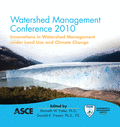Climate Change and TMDLs: Anticipating Potential Effects/Weighing Options
Publication: Watershed Management 2010: Innovations in Watershed Management under Land Use and Climate Change
Abstract
This paper describes an ongoing U.S. EPA project to study the potential effects of climate change on water quality-based management plans and TMDLs. The project consists of two phases, the first of which is an examination of precipitation and streamflow changes that have occurred at selected sites across the Upper Midwest region. Assessing historic hydrologic changes (e.g., frequency, magnitude, seasonal variation) can help reveal ongoing processes and highlight factors to consider relative to climate change. The assessment of historic changes can also help to identify what information best describes potential future conditions for any given area, which is a significant challenge currently facing watershed managers (i.e., how will climate change affect specific locales?). The premise of this study is that an assessment of historical weather observations can provide a description of existing seasonal and spatial variability as well as trends that may be extrapolated into the future. To accomplish this objective, historic records of precipitation at several sites in the Upper Midwest will be examined, focusing on changes in annual precipitation, the percent of days with measurable precipitation, rainfall intensity, and seasonal patterns. Historic streamflow data is evaluated through the use of flow duration curves to provide insight into the type of effects climate change may have on TMDLs. Duration curves describe patterns across the full range of flow conditions. The potential effects of higher stream discharge due to increased storm intensity or lower flows resulting from more frequent droughts become apparent with duration curves. Because they are often used to define the loading capacity, duration curves represent a logical starting point to assess the implications of climate change on TMDLs. Rainfall-runoff models will also be used to examine the effect of potential changes in precipitation and temperature. In particular, rainfall-runoff models can be used to assess the sensitivity of a range of future scenarios based on historic data. For example, historic precipitation data can be increased by 20 percent across the entire year to evaluate the potential impacts to hydrology. The second phase of the project incorporates water quality information into the analysis. Information on loading rates for common TMDL parameters will be compiled (e.g., sediment, nutrients, bacteria) and the effect of hydrologic changes on these parameters will be examined as a starting point for describing potential implications relative to water quality. Many studies have described the effect of flow on in-stream sediment concentrations and loads. For instance, rating curves have been used to provide quantitative estimates of the relationship between flow and sediment. The potential effect of altered hydrology on water quality can thus be examined by applying a unit area sediment rating curve to duration curves that reflect pre- and post- climate change conditions.
Get full access to this article
View all available purchase options and get full access to this chapter.
Information & Authors
Information
Published In
Copyright
© 2010 American Society of Civil Engineers.
History
Published online: Apr 26, 2012
Authors
Metrics & Citations
Metrics
Citations
Download citation
If you have the appropriate software installed, you can download article citation data to the citation manager of your choice. Simply select your manager software from the list below and click Download.
